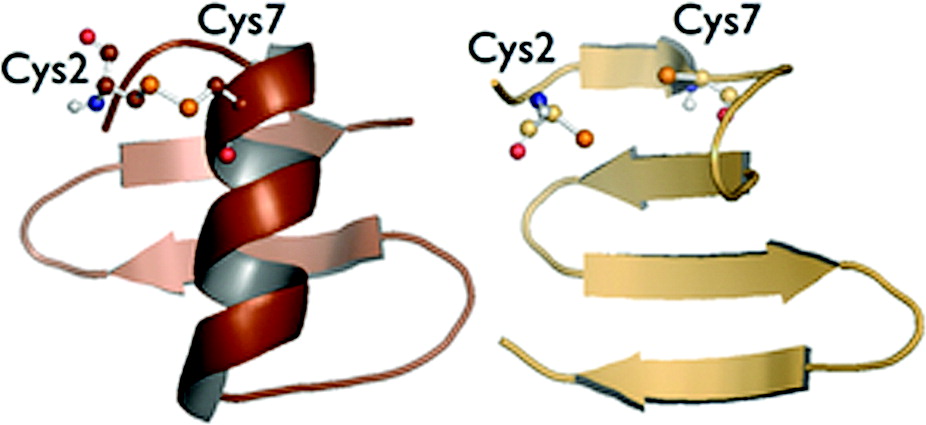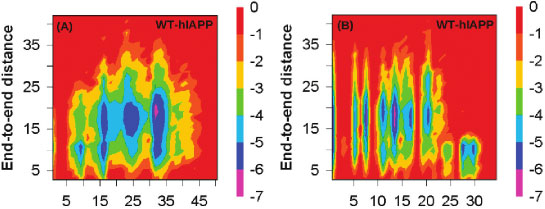

In this study we introduced a combination of Hamiltonian and temperature REMD, which mixes temperature and interaction strength in order to facilitate configurational sampling for dense polymers, such as large proteins and aggregates. The standard T-REMD can hardly explore the configurational space for the complex systems even at high temperature. In paper number 13 in the CV we showed that this algorithm converges faster than T-REMD to thermodynamical equilibrium, the efficiency gain of HT-REMD over T-REMD for monomeric IAPP is about a factor of 3, the improvement will be significant for oligomers and longer chains. We characterized the atomic structure and the thermodynamics of the human Islet amyloid polypeptide (hIAPP ) which is a 37-residue peptide hormone and its amyloid deposits are found in more than 95% of type-II diabetes patients. We studied full-length hIAPP in monomeric
and dimeric forms, in presence and absence of the disulfide bond between Cys2 and Cys7 residues which plays an important role in the process of the aggregation and fibril formation. We also study the monomeric and dimeric Rat-IAPP which differ from the human IAPP by only 6 amino acids in the C-terminal but it is not able to form fibrils. We demonstrated that all the monomers and dimers sample
α-helical structure in the N-terminal region, however, the length of the α-helices are shorter and they are not stable for the chains without the disulfide bridge while it is very stable even at high temperatures in the presence of the disulfide bridge and it covers the larger numbers of residues (residues 5-17 for hIAPP with the bridge vs. 10-17 for hIAPP without the bridge). The α-helix structure in the N-terminal region of hIAPP is shown to be an important transient stage in the formation of oligomers. The disulfide bond greatly stabilizes that α-helical structure. In the C-terminal region which is the amyloidogenic region of the hIAPP, β-strands is seen for residues 22-26 and 30-35. In the Rat-IAPP, however, neither monomer nor dimer show any significant β-content in the C-terminal as the three proline residues tend to form turn and not β-sheet. These numerical results are fully consistent with recent experiments that show the N-terminal residues which are not part of the fibril form α-helix structure which play a role in insertion into the membrane while the amyloidogenic region of the hIAPP C-terminal) is outside of the membrane and is available for the fibrillation.
The Effect of Disulfide Bond on the Monomeric Structure of Human Amylin Studied by Combined Hamiltonian and Temperature Replica Exchange Molecular Dynamics Simulations. Rozita Laghaei, Normand Mousseau and Guanghong Wei, J. Phys. Chem. B, 2010; 114 , 7071.
Structure
and thermodynamics of amylin dimer studied by
Hamiltonian-temperature replica exchange molecular dynamics
simulations, Rozita Laghaei, Normand Mousseau and Guanghong Wei, J. Phys. Chem. B 115, 3146–3154 (2011).